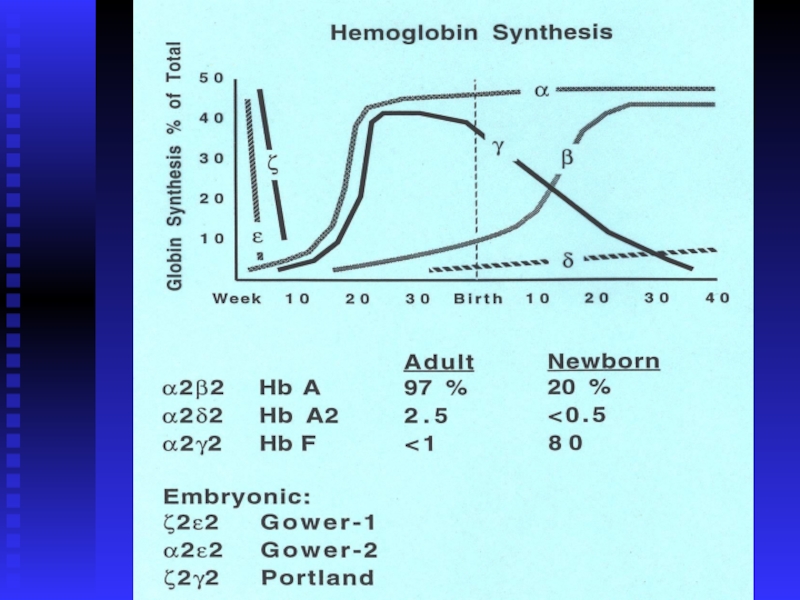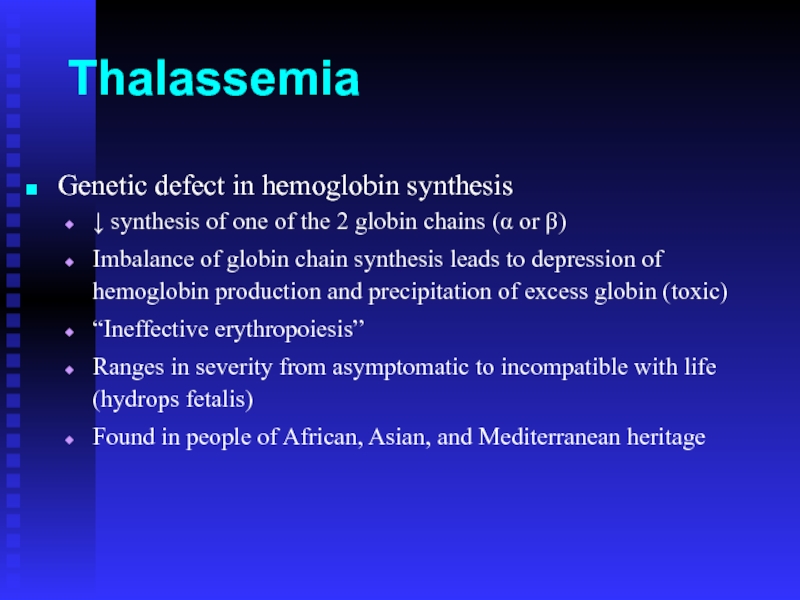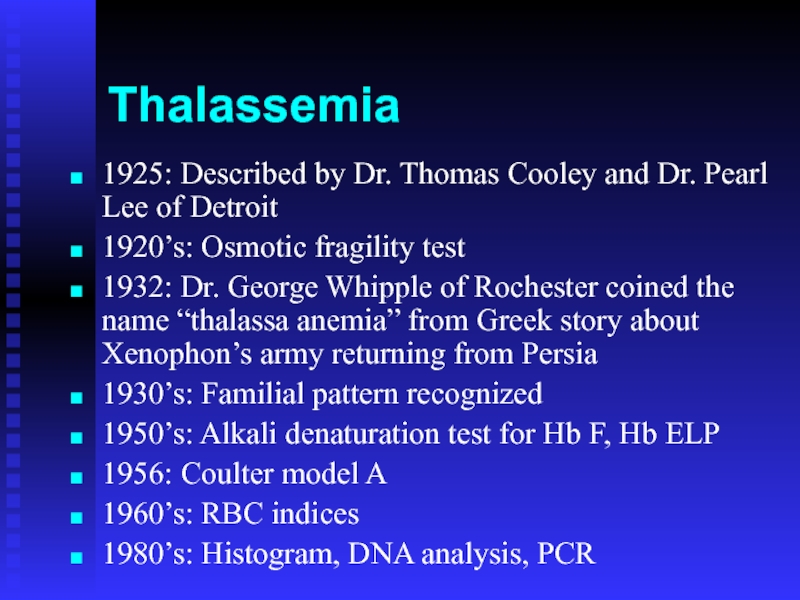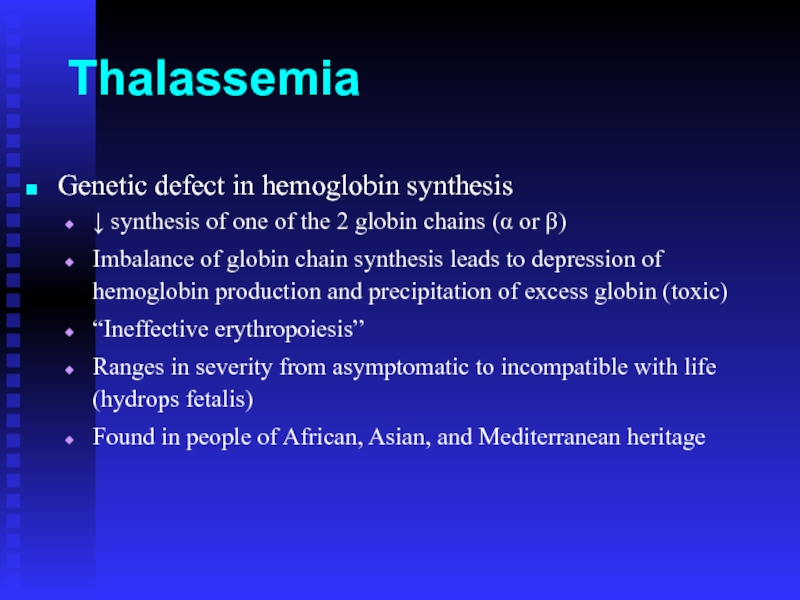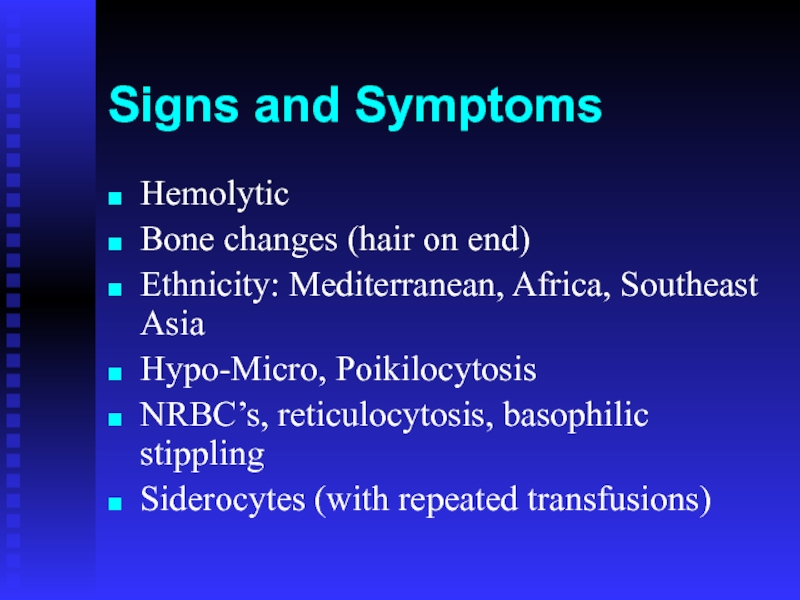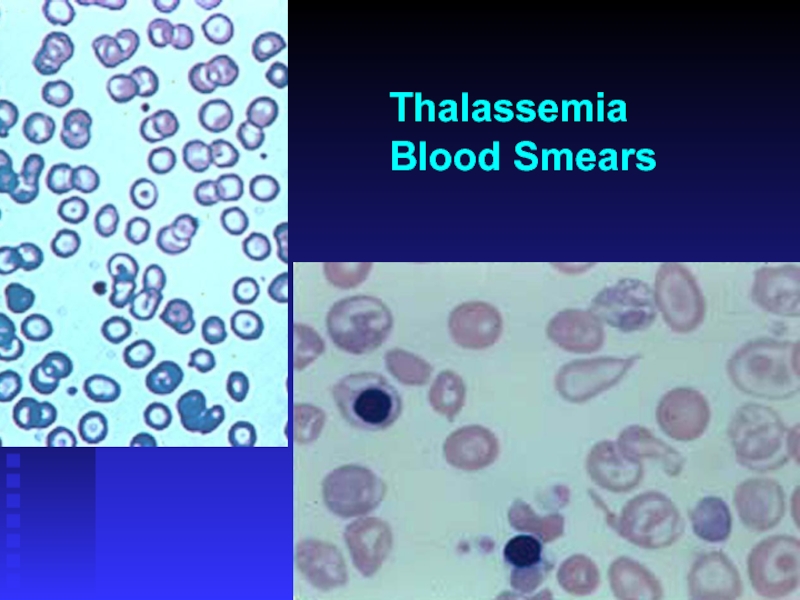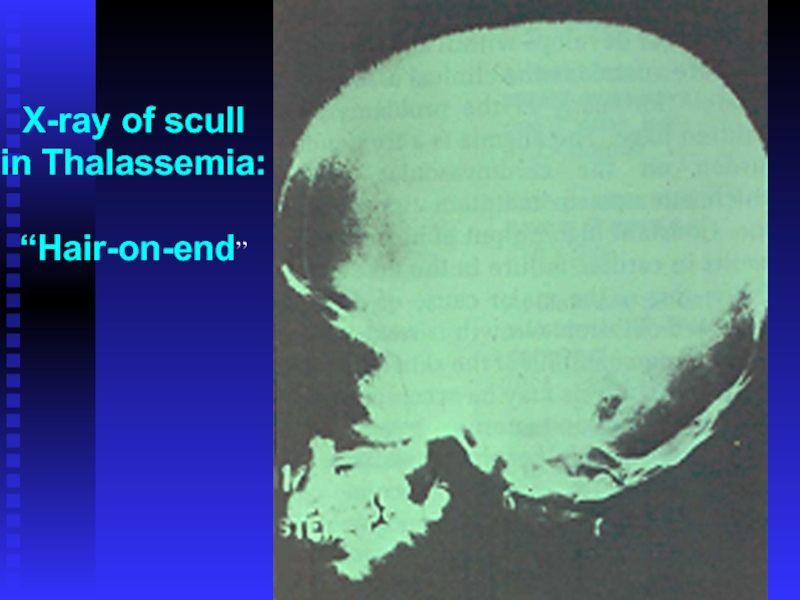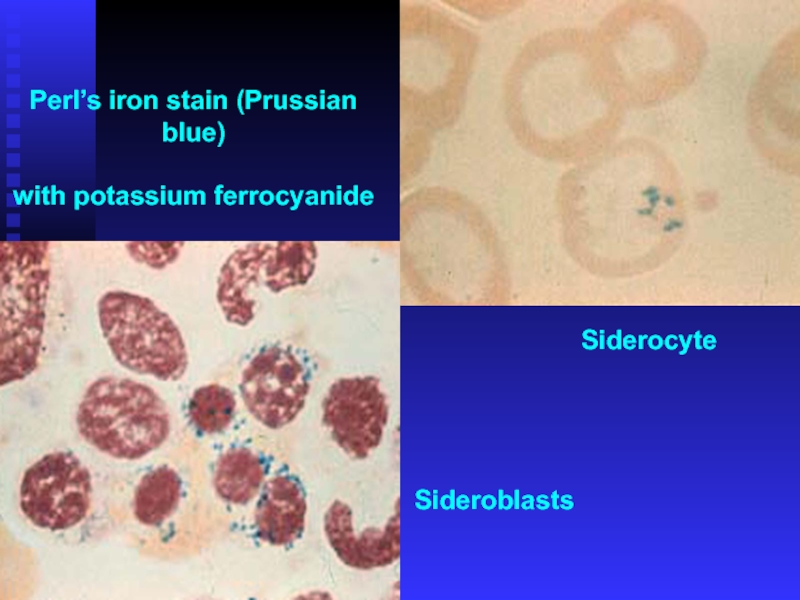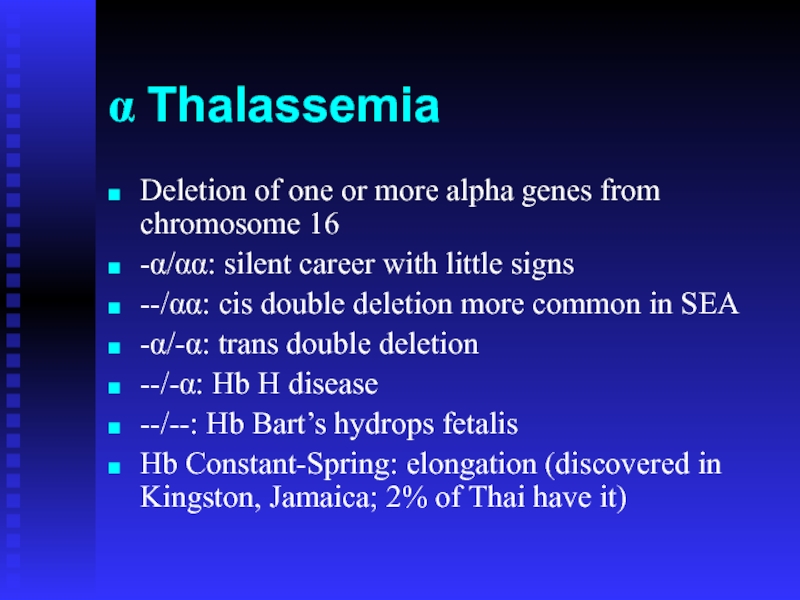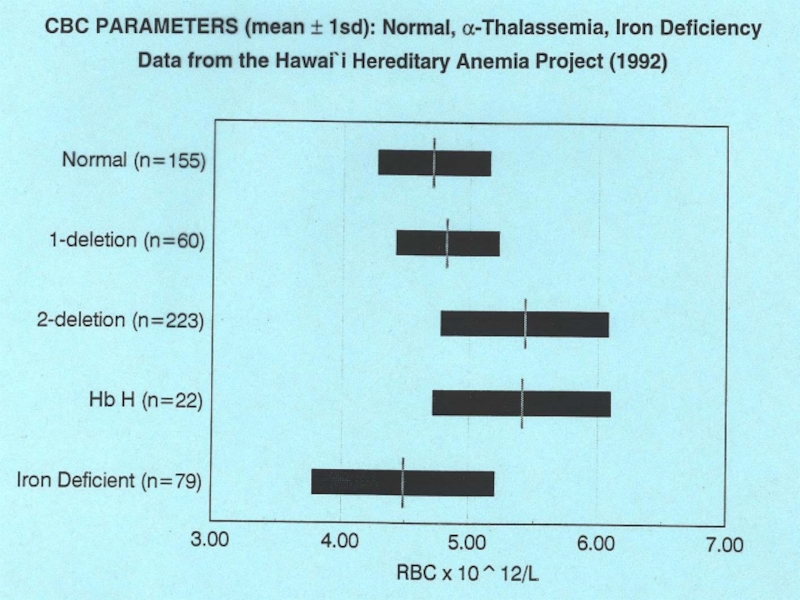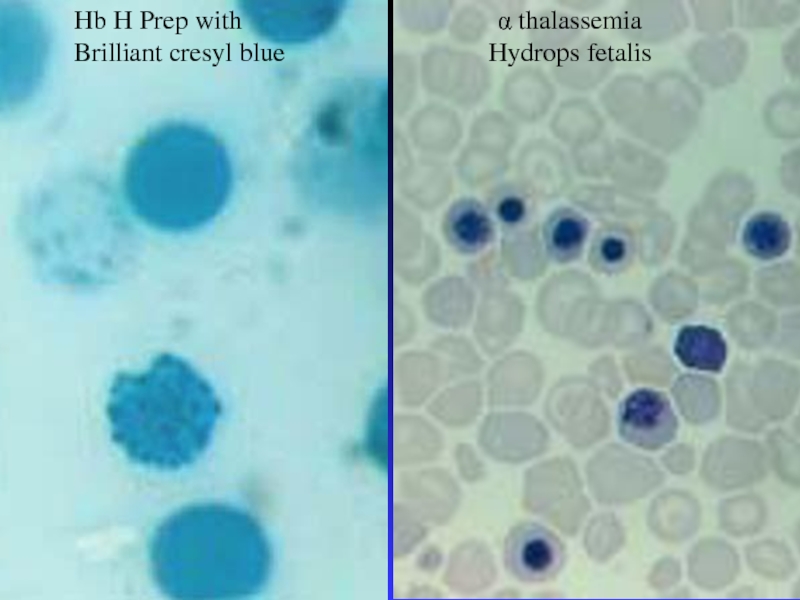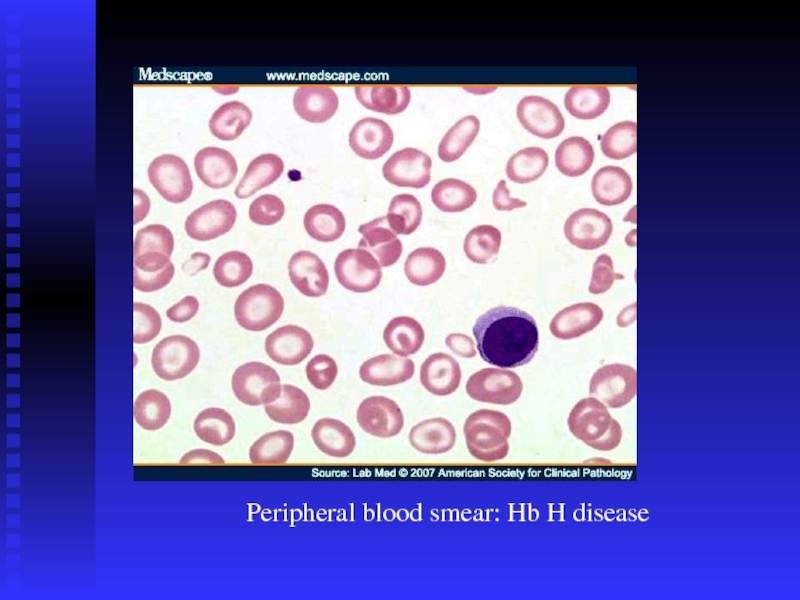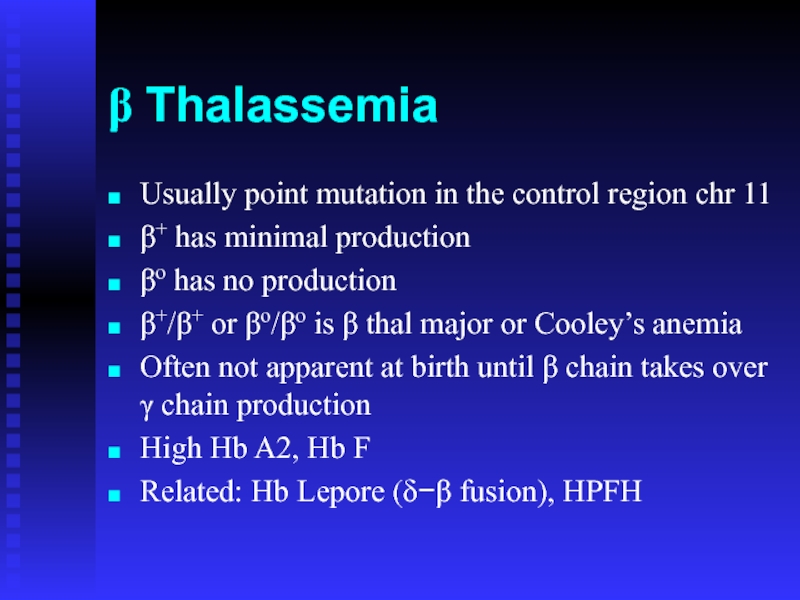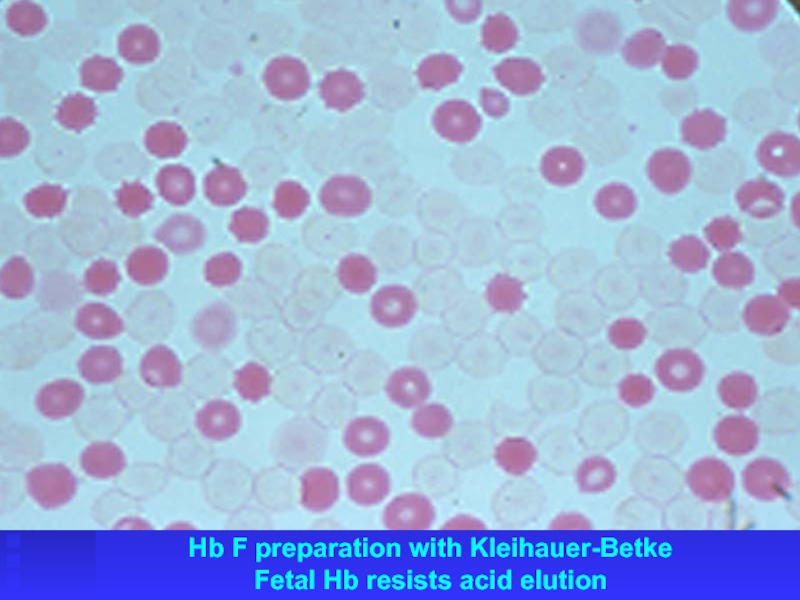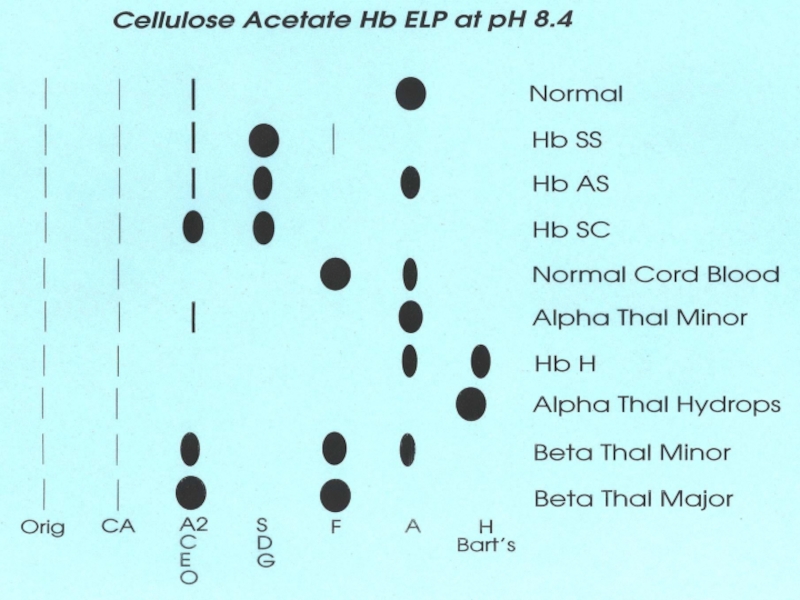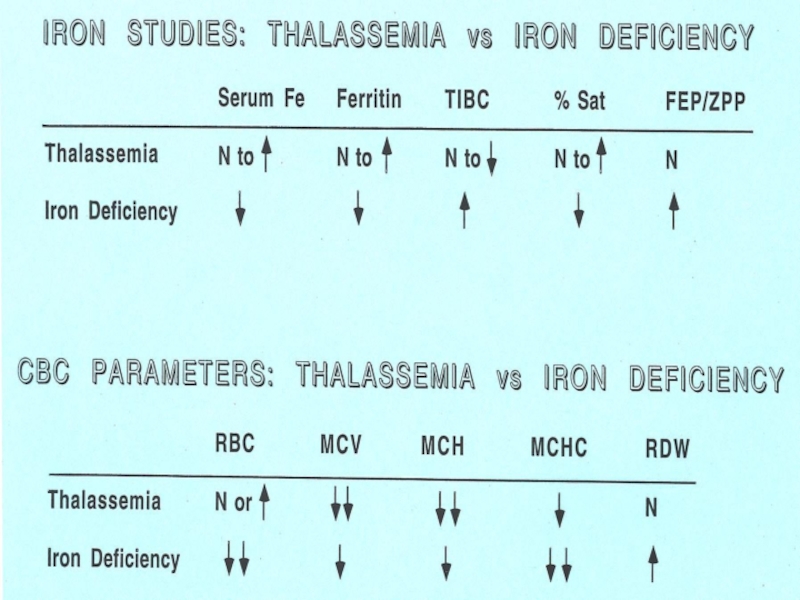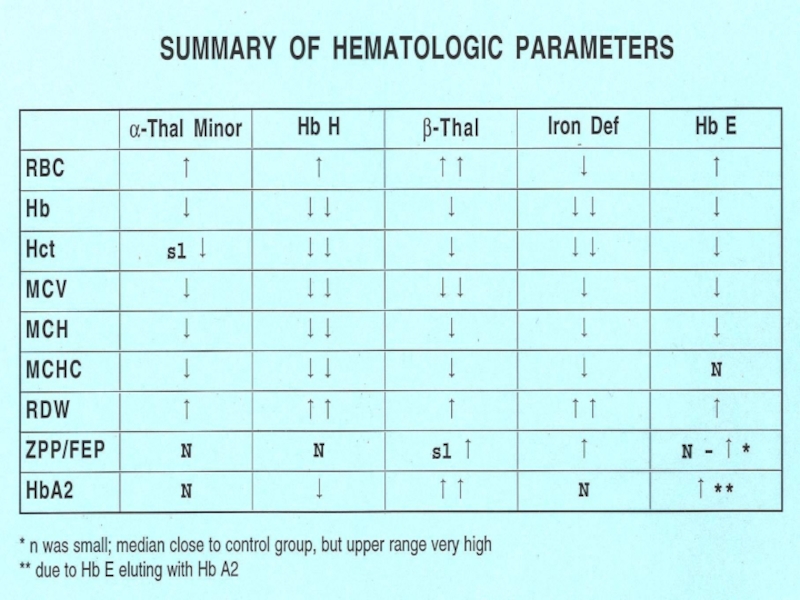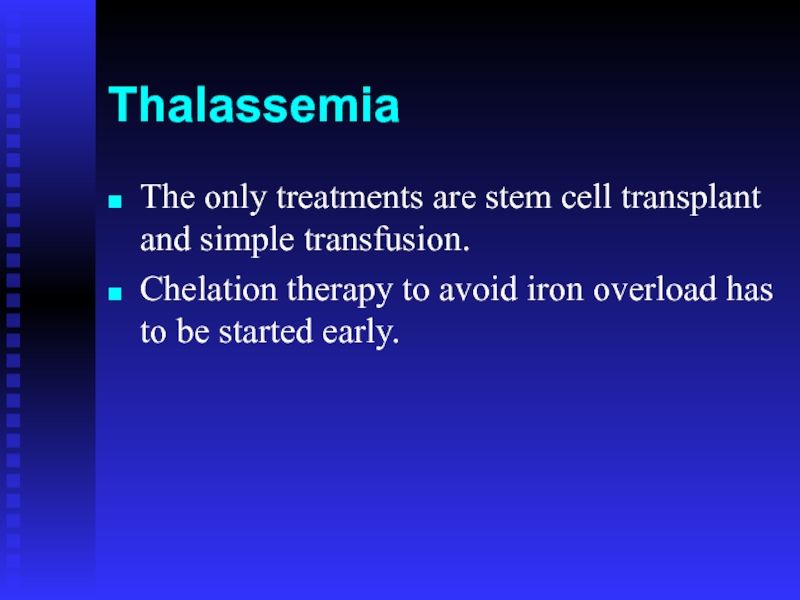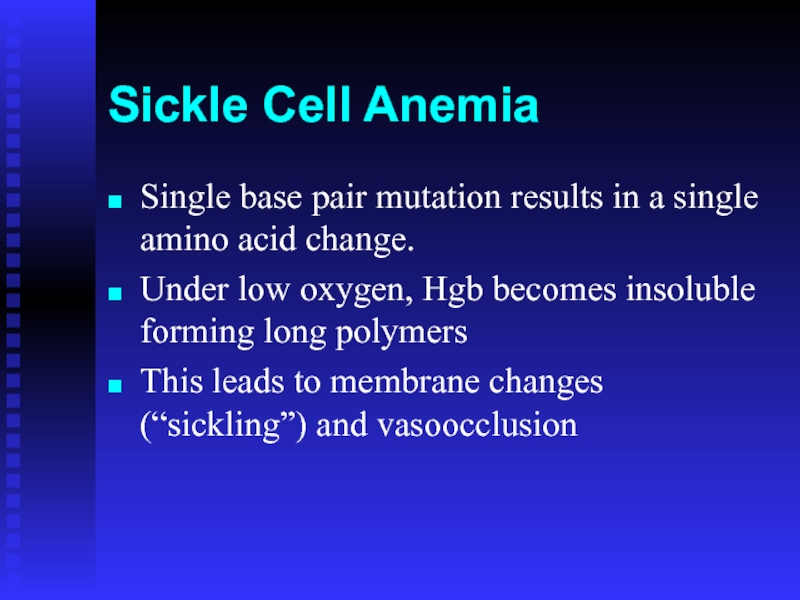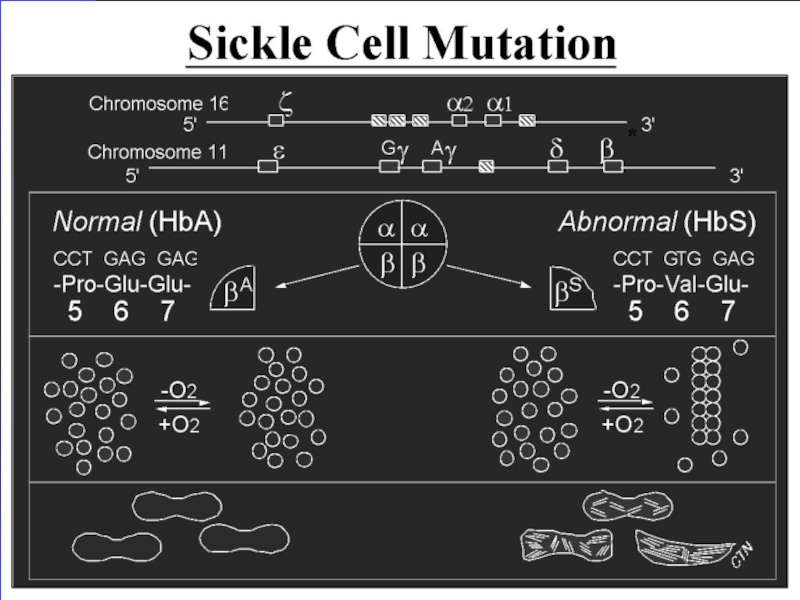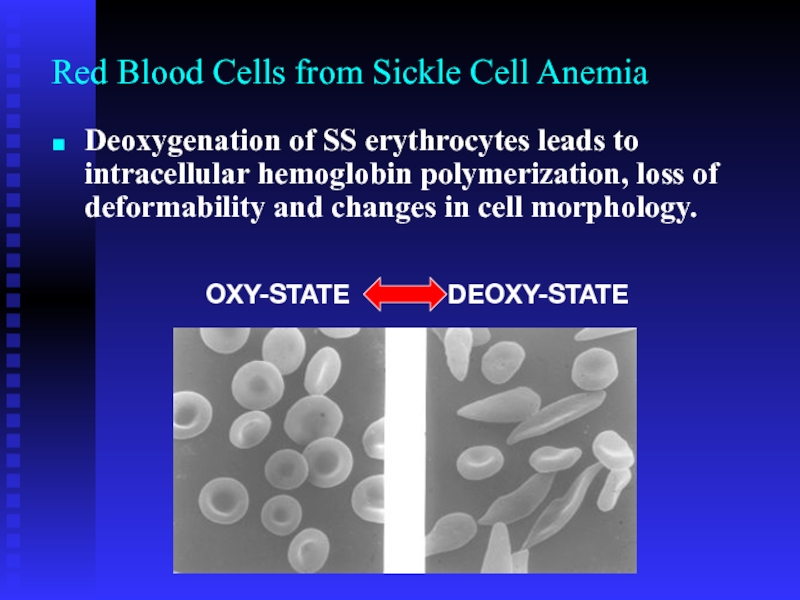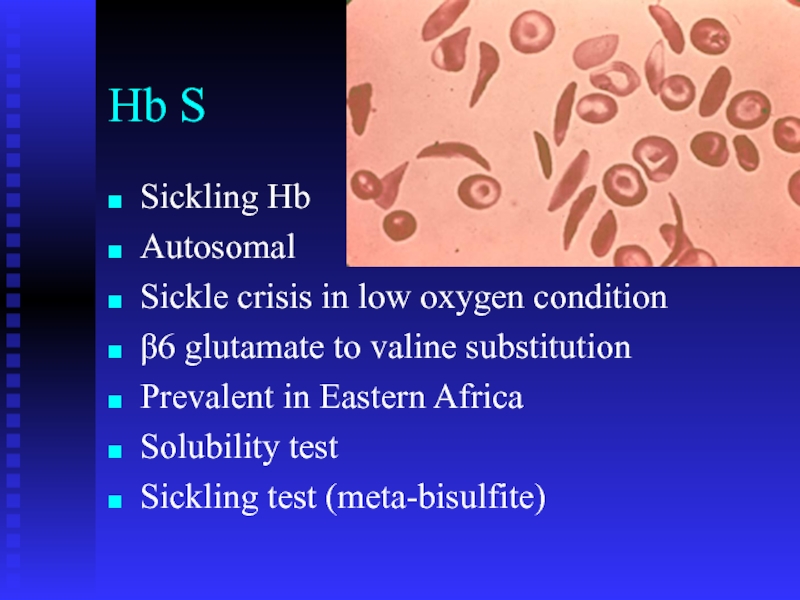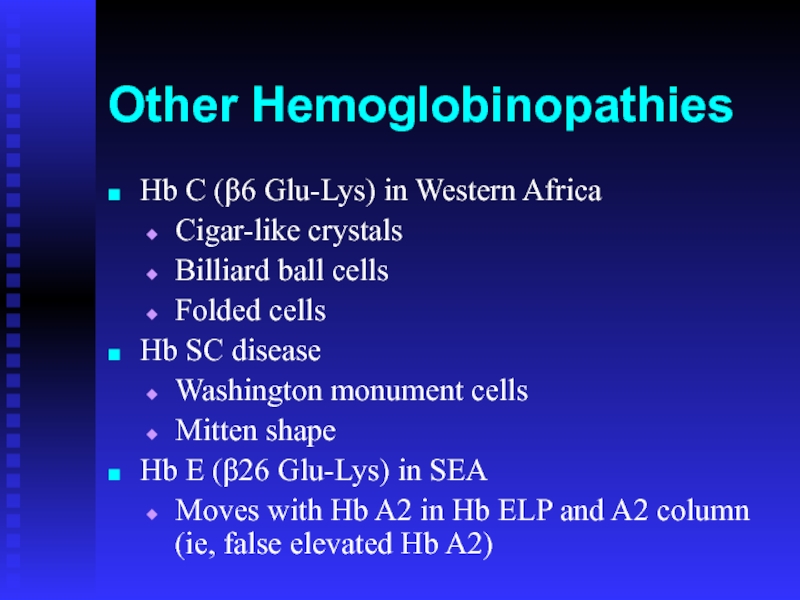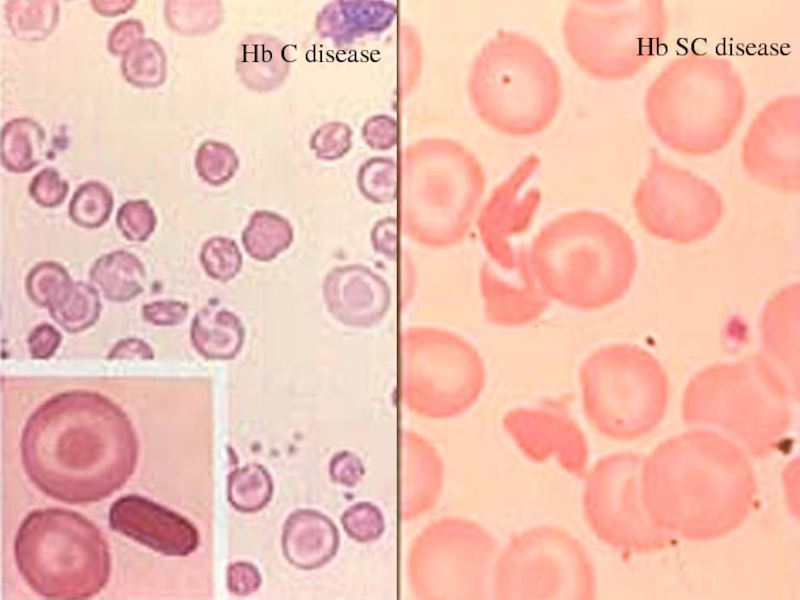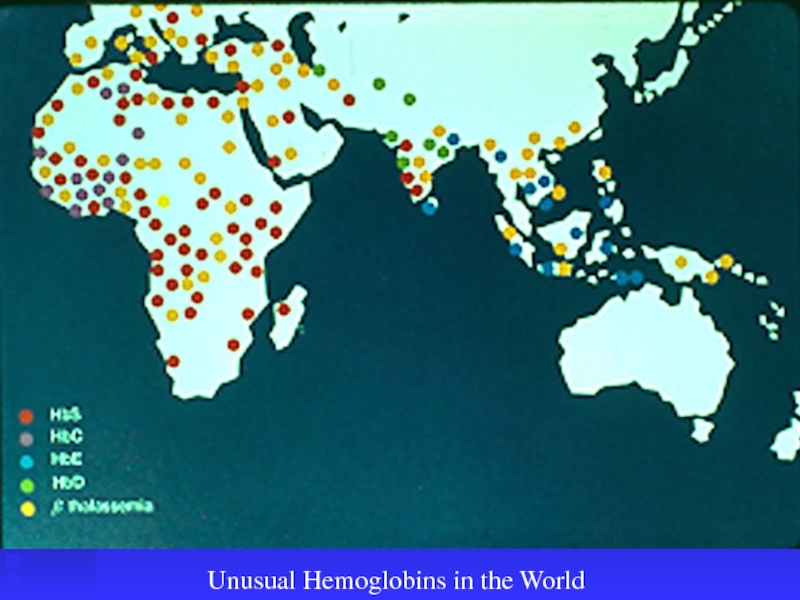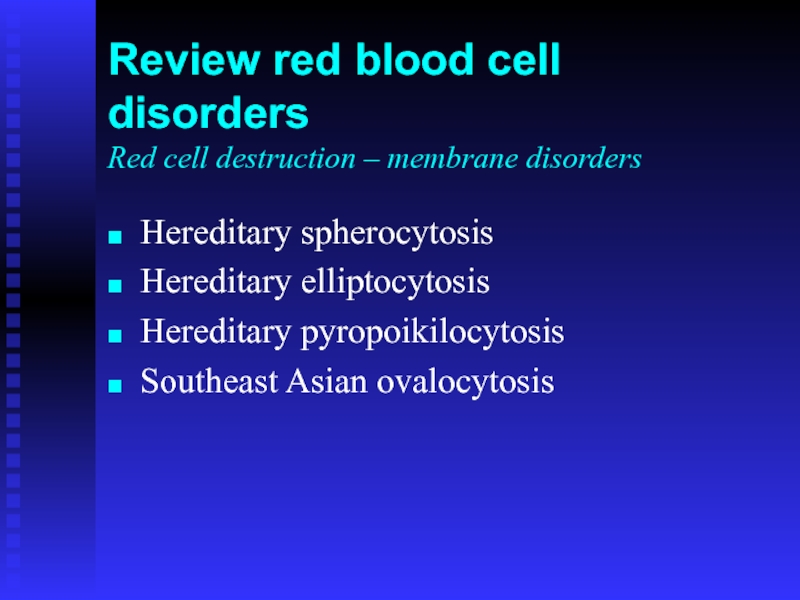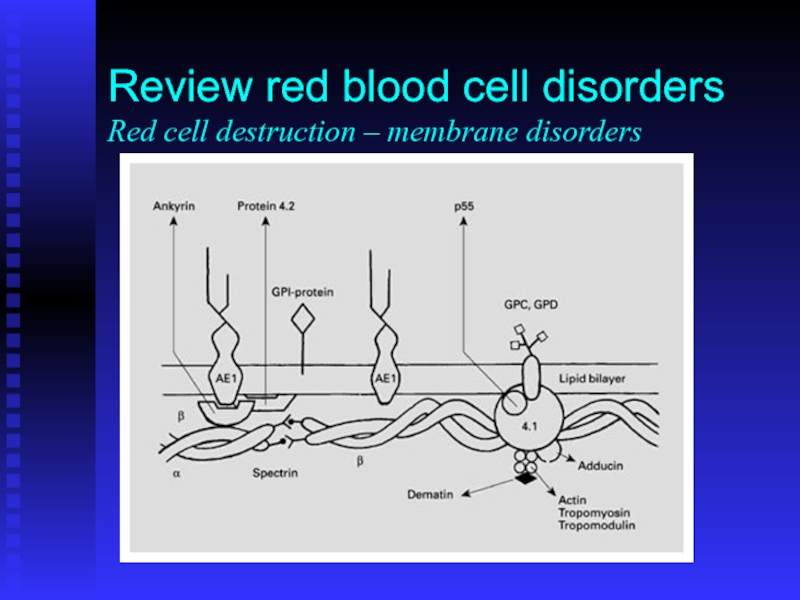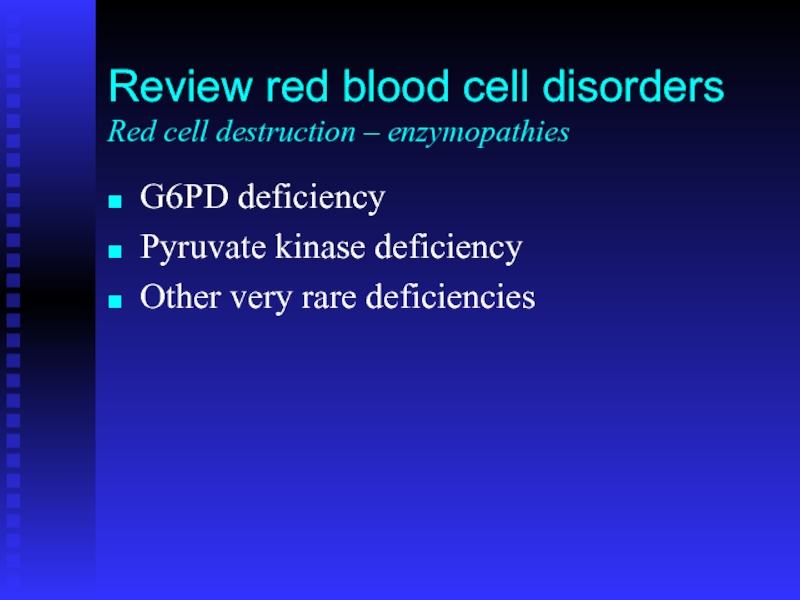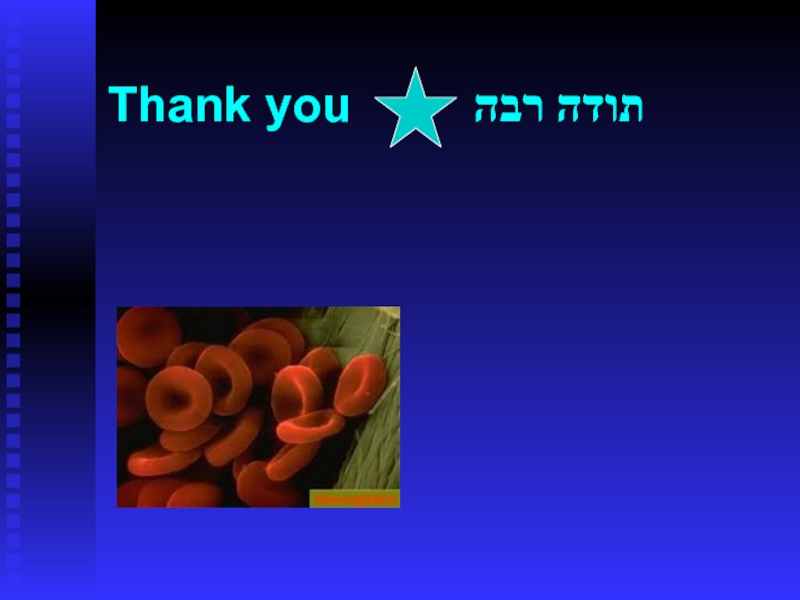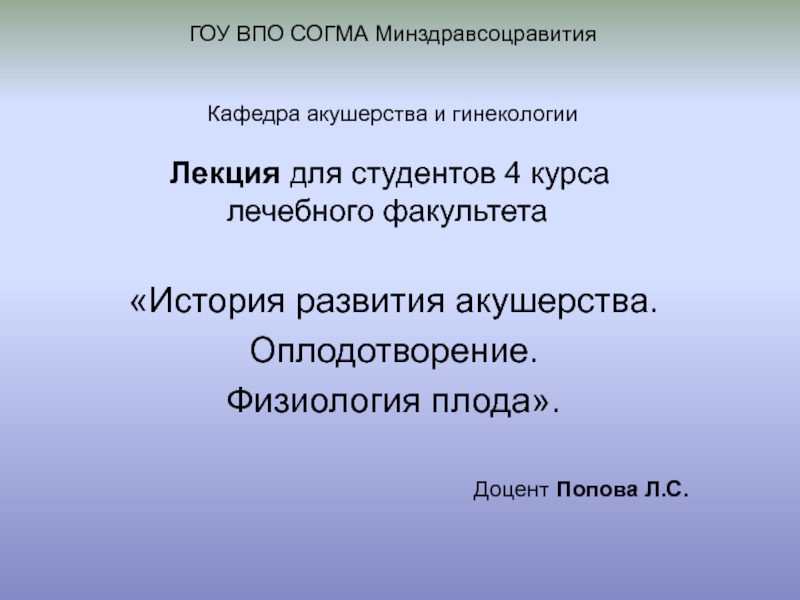- Главная
- Разное
- Дизайн
- Бизнес и предпринимательство
- Аналитика
- Образование
- Развлечения
- Красота и здоровье
- Финансы
- Государство
- Путешествия
- Спорт
- Недвижимость
- Армия
- Графика
- Культурология
- Еда и кулинария
- Лингвистика
- Английский язык
- Астрономия
- Алгебра
- Биология
- География
- Детские презентации
- Информатика
- История
- Литература
- Маркетинг
- Математика
- Медицина
- Менеджмент
- Музыка
- МХК
- Немецкий язык
- ОБЖ
- Обществознание
- Окружающий мир
- Педагогика
- Русский язык
- Технология
- Физика
- Философия
- Химия
- Шаблоны, картинки для презентаций
- Экология
- Экономика
- Юриспруденция
Hemoglobinopathies. Hb structure презентация
Содержание
- 1. Hemoglobinopathies. Hb structure
- 2. Hb structure
- 4. Hb dissociation curve
- 5. Anemia Production? Survival/Destruction? The key test is the ….. ?
- 6. The reticulocyte count (kinetic approach) Increased reticulocytes
- 7. Causes of Anemia Decreased erythrocyte
- 8. First, measure the size of the
- 9. Underproduction macrocytic MCV>115 B12, Folate Drugs that
- 10. Underproduction Normocytic Anemia of chronic disease Mixed
- 11. Review red blood cell disorders Marrow production
- 12. Acquired Immunological Toxins – Benzene Drugs –
- 13. Preleukemia, most commonly in the elderly. Supportive
- 14. Anemia associated with marrow infiltration “teardrops” Cancer,
- 15. Elevated reticulocyte count Mechanical Autoimmune Drug Congenital
- 16. Hb Problems Heme production problem: porphyria Fe
- 18. Hemoglobinopathies Decrease, lack of, or abnormal globin
- 19. Hemoglobin Heme Porphyrin ring and Fe Globins
- 21. Thalassemia Genetic defect in hemoglobin synthesis ↓
- 22. Thalassemia 1925: Described by Dr. Thomas Cooley
- 23. Thalassemia Genetic defect in hemoglobin synthesis ↓
- 24. Signs and Symptoms Hemolytic Bone changes (hair
- 25. Thalassemia Blood Smears
- 26. X-ray of scull in Thalassemia: “Hair-on-end”
- 27. Perl’s iron stain (Prussian blue) with potassium ferrocyanide Siderocyte Sideroblasts
- 28. α Thalassemia Deletion of one or more
- 29. α Thalassemia Lab Changes High RBC Low
- 31. Hb H Prep with Brilliant cresyl blue α thalassemia Hydrops fetalis
- 32. Peripheral blood smear: Hb H disease
- 33. β Thalassemia Usually point mutation in the
- 34. Hb F preparation with Kleihauer-Betke Fetal Hb resists acid elution
- 38. Thalassemia The only treatments are stem cell
- 39. Sickle Cell Anemia Single base pair mutation
- 41. Red Blood Cells from Sickle Cell Anemia
- 42. Hb S Sickling Hb Autosomal Sickle crisis
- 43. Other Hemoglobinopathies Hb C (β6 Glu-Lys) in
- 44. Hb SC disease Hb C disease
- 45. Unusual Hemoglobins in the World
- 46. Hereditary spherocytosis Hereditary elliptocytosis Hereditary pyropoikilocytosis Southeast
- 47. Review red blood cell disorders Red cell destruction – membrane disorders
- 48. G6PD deficiency Pyruvate kinase deficiency Other very
- 49. Thank you תודה רבה
Слайд 1Hemoglobinopathies
Hemoglobinopathies
Thalassemia genetics
Hb synthesis
Hb A, A2, F
Hb ELP
Hb Constant-Spring
Hb Bart’s
Hb H
Hb Lepore
Hb
Hb S
Hb C
Hb SC disease
HPFH
Слайд 6The reticulocyte count
(kinetic approach)
Increased reticulocytes (greater than 2-3% or 100,000/mm3 total)
Retic counts are most helpful if extremely low (<0.1%) or greater than 3% (100,000/mm3 total).
Слайд 7Causes of Anemia
Decreased erythrocyte production
Decreased erythropoietin
Inadequate marrow response to erythropoietin
Erythrocyte loss
Hemorrhage
Hemolysis
Слайд 8
First, measure the size of the RBCs:
Use of volume-sensitive automated
Other automated counters measure red blood cell volume by means of techniques that measure refracted, diffracted, or scattered light
By calculation
Morphological Approach
(big versus little)
Слайд 9Underproduction macrocytic
MCV>115
B12, Folate
Drugs that impair DNA synthesis (AZT, chemo)
MDS
MCV 100 -
Endocrinopathy (hypothyroidism)
Erythropoetin
Reticulocytosis
Слайд 10Underproduction
Normocytic
Anemia of chronic disease
Mixed deficiencies
Renal failure
MM, Lymphoma
Microcytic
Iron deficiency
Thalassemia
Anemia of chronic disease
Sideroblastic anemias
Слайд 11Review red blood cell disorders
Marrow production
Thalassemias
Myelodysplasia
Myelophthisic
Aplastic anemia
Nutritional deficiencies
Red cell destruction
Hemoglobinopathies
Enzymopathies
Membrane disorders
Autoimmune
Слайд 12Acquired
Immunological
Toxins – Benzene
Drugs – methotrexate, chloramphenicol
Viruses – EBV, hepatitis
Hereditary
Fanconi,
Diamond-Shwachman
Review red blood
Слайд 13Preleukemia, most commonly in the elderly.
Supportive care that involves transfusion therapy
Poor response to growth factors
Review red blood cell disorders
Marrow Production - Myelodysplasia
Слайд 14Anemia associated with marrow infiltration
“teardrops”
Cancer, infections
Myelofibrosis
Treatment is aimed at the
Supportive transfusions as needed.
Review red blood cell disorders
Marrow Production - Myelophthisic
Слайд 15Elevated reticulocyte count
Mechanical
Autoimmune
Drug
Congenital
Review red blood cell disorders
Red cell destruction
Слайд 16Hb Problems
Heme production problem: porphyria
Fe incorporation into Heme: Sideroblastic anemia
Fe++ problems:
Globin problem: sickle cell disease, thalassemia
Слайд 18Hemoglobinopathies
Decrease, lack of, or abnormal globin
May be severe hemolytic anemia
Abnormal Hb
Mutation may be deletion, substitution, elongation
Hb electrophoresis may be helpful
Слайд 19Hemoglobin
Heme
Porphyrin ring and Fe
Globins
Alpha family on chromosome 16
−−[ζ]--//--[α2]−−[α1]−−
Beta family on chromosome
−−[ε]--//--[γ]--[γ]−−[δ]−−[β]−−
Слайд 21Thalassemia
Genetic defect in hemoglobin synthesis
↓ synthesis of one of the 2
Imbalance of globin chain synthesis leads to depression of hemoglobin production and precipitation of excess globin (toxic)
“Ineffective erythropoiesis”
Ranges in severity from asymptomatic to incompatible with life (hydrops fetalis)
Found in people of African, Asian, and Mediterranean heritage
Слайд 22Thalassemia
1925: Described by Dr. Thomas Cooley and Dr. Pearl Lee of
1920’s: Osmotic fragility test
1932: Dr. George Whipple of Rochester coined the name “thalassa anemia” from Greek story about Xenophon’s army returning from Persia
1930’s: Familial pattern recognized
1950’s: Alkali denaturation test for Hb F, Hb ELP
1956: Coulter model A
1960’s: RBC indices
1980’s: Histogram, DNA analysis, PCR
Слайд 23Thalassemia
Genetic defect in hemoglobin synthesis
↓ synthesis of one of the 2
Imbalance of globin chain synthesis leads to depression of hemoglobin production and precipitation of excess globin (toxic)
“Ineffective erythropoiesis”
Ranges in severity from asymptomatic to incompatible with life (hydrops fetalis)
Found in people of African, Asian, and Mediterranean heritage
Слайд 24Signs and Symptoms
Hemolytic
Bone changes (hair on end)
Ethnicity: Mediterranean, Africa, Southeast Asia
Hypo-Micro,
NRBC’s, reticulocytosis, basophilic stippling
Siderocytes (with repeated transfusions)
Слайд 28α Thalassemia
Deletion of one or more alpha genes from chromosome 16
-α/αα:
--/αα: cis double deletion more common in SEA
-α/-α: trans double deletion
--/-α: Hb H disease
--/--: Hb Bart’s hydrops fetalis
Hb Constant-Spring: elongation (discovered in Kingston, Jamaica; 2% of Thai have it)
Слайд 29α Thalassemia Lab Changes
High RBC
Low H&H and indices
High RDW
May need to
Hb ELP not useful except in Hb H
BCB prep for Hb H
Слайд 33β Thalassemia
Usually point mutation in the control region chr 11
β+ has
βo has no production
β+/β+ or βo/βo is β thal major or Cooley’s anemia
Often not apparent at birth until β chain takes over γ chain production
High Hb A2, Hb F
Related: Hb Lepore (δ−β fusion), HPFH
Слайд 38Thalassemia
The only treatments are stem cell transplant and simple transfusion.
Chelation therapy
Слайд 39Sickle Cell Anemia
Single base pair mutation results in a single amino
Under low oxygen, Hgb becomes insoluble forming long polymers
This leads to membrane changes (“sickling”) and vasoocclusion
Слайд 41Red Blood Cells from Sickle Cell Anemia
OXY-STATE
DEOXY-STATE
Deoxygenation of SS erythrocytes leads
Слайд 42Hb S
Sickling Hb
Autosomal
Sickle crisis in low oxygen condition
β6 glutamate to valine
Prevalent in Eastern Africa
Solubility test
Sickling test (meta-bisulfite)
Слайд 43Other Hemoglobinopathies
Hb C (β6 Glu-Lys) in Western Africa
Cigar-like crystals
Billiard ball cells
Folded
Hb SC disease
Washington monument cells
Mitten shape
Hb E (β26 Glu-Lys) in SEA
Moves with Hb A2 in Hb ELP and A2 column (ie, false elevated Hb A2)
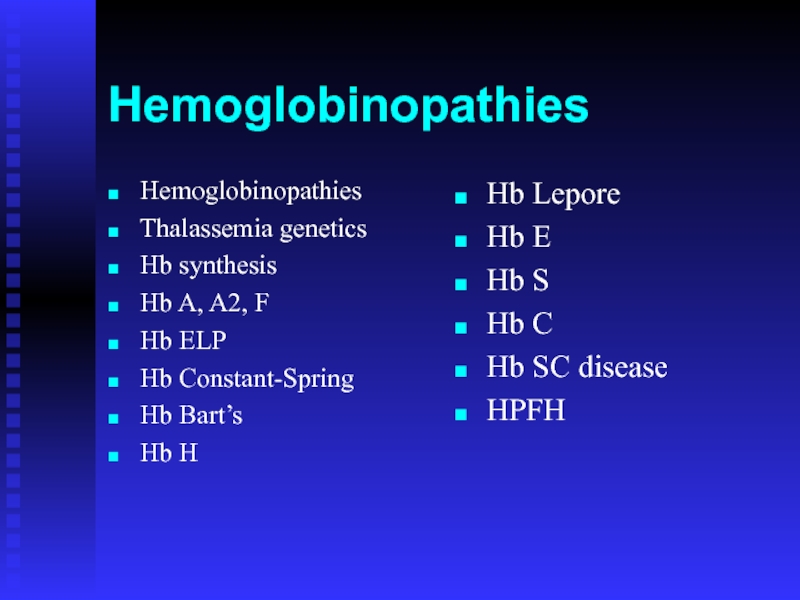
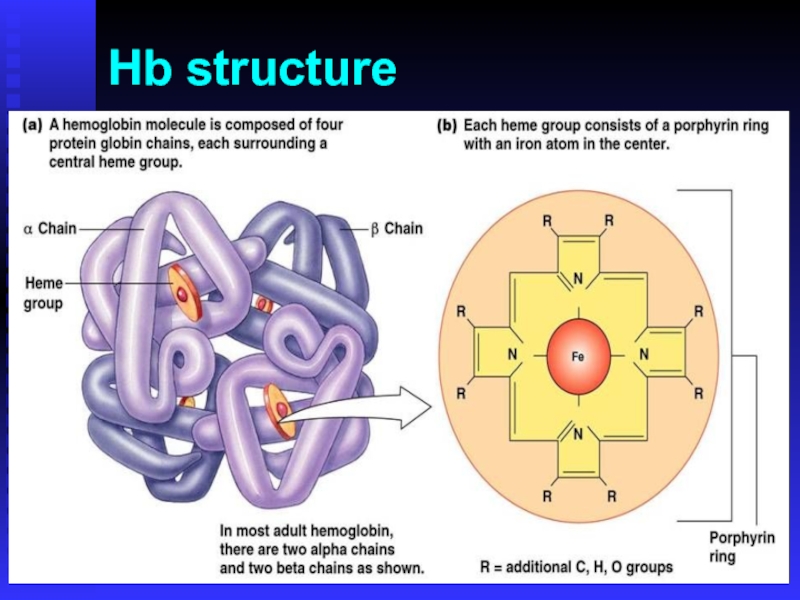
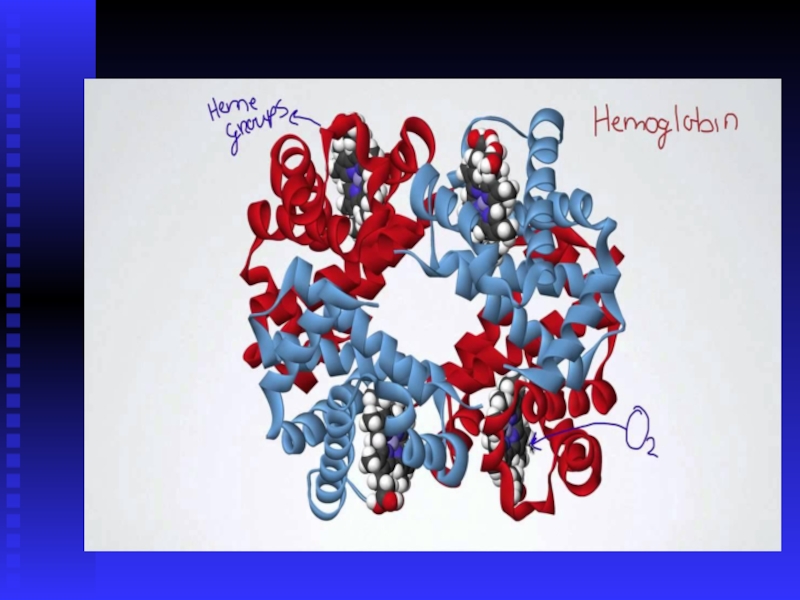
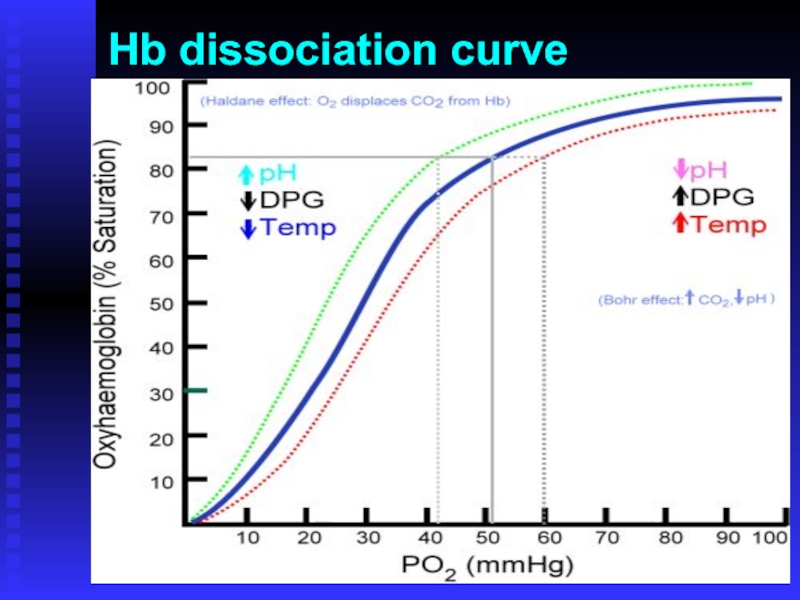
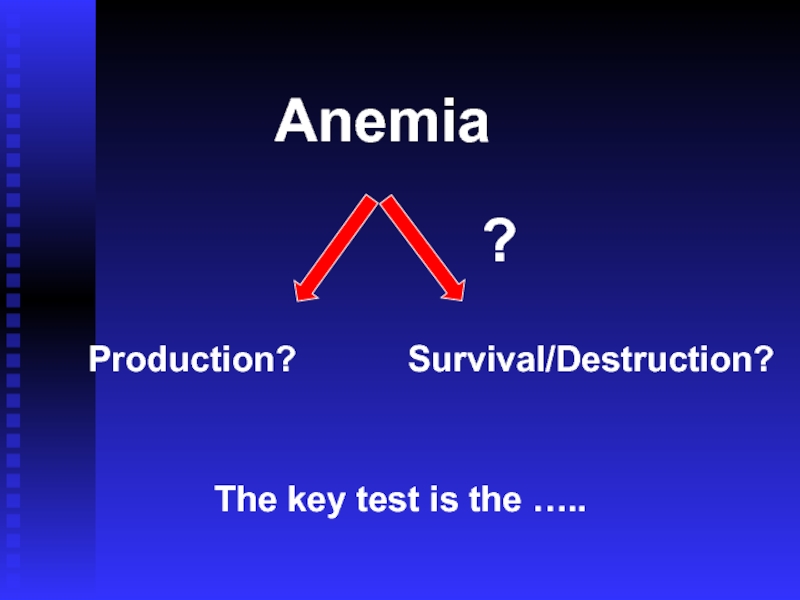
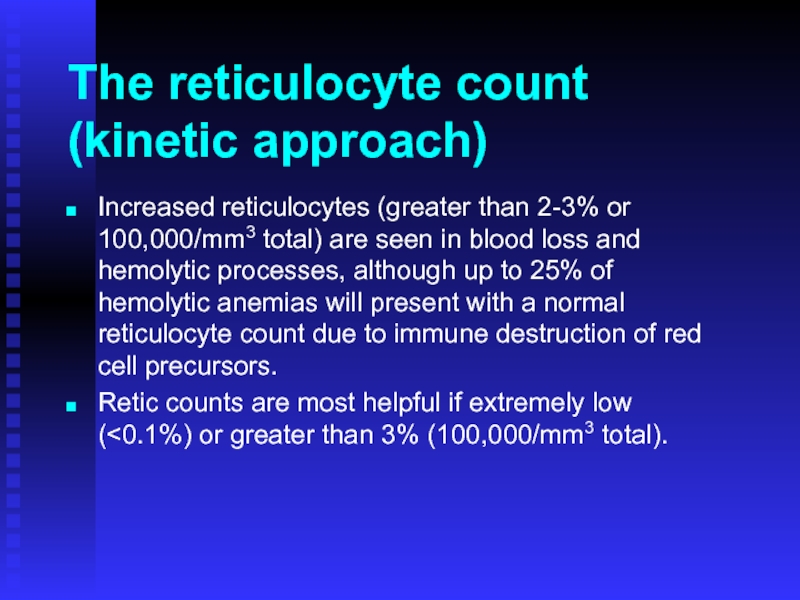
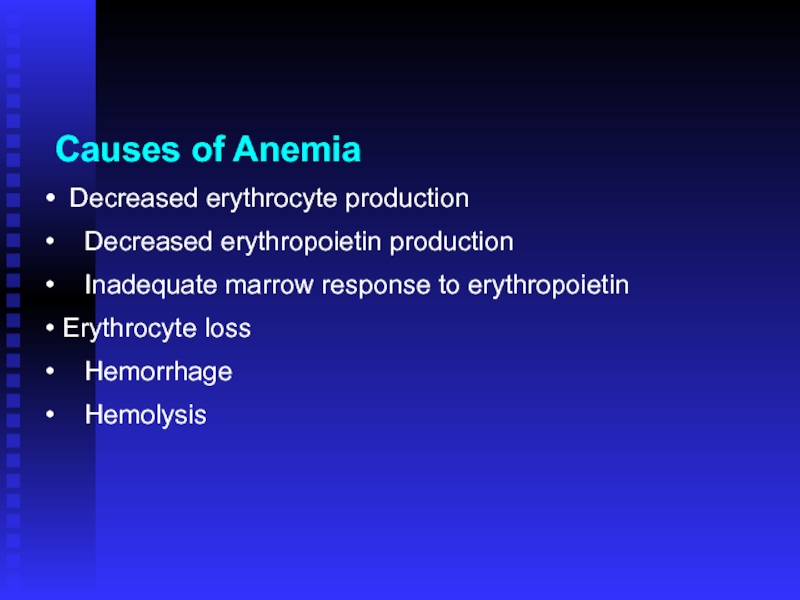
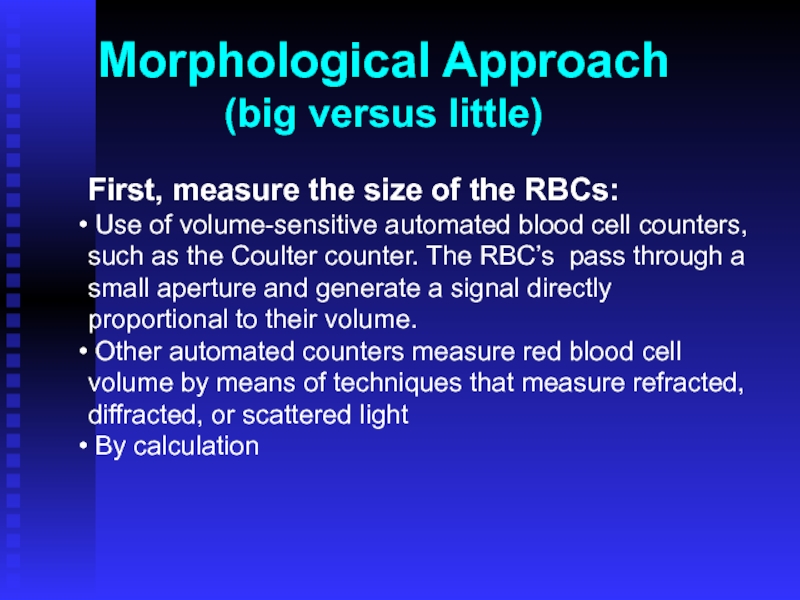
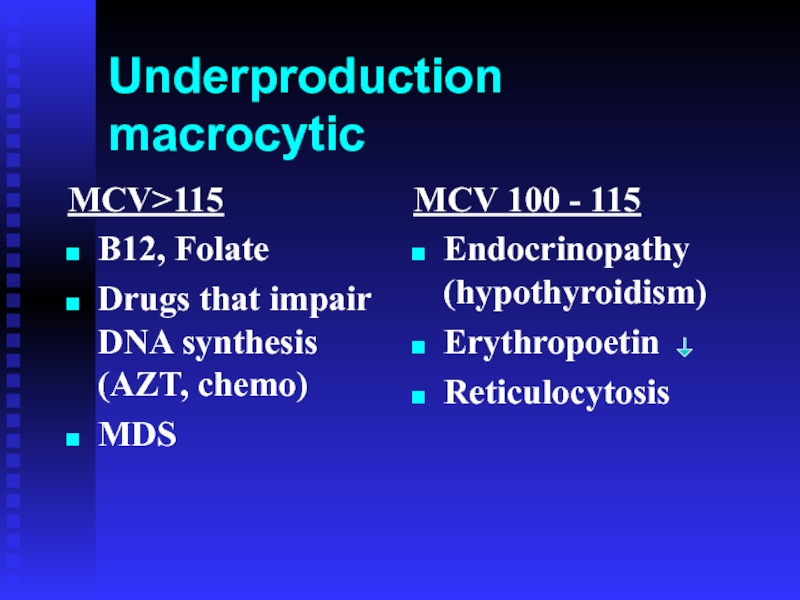
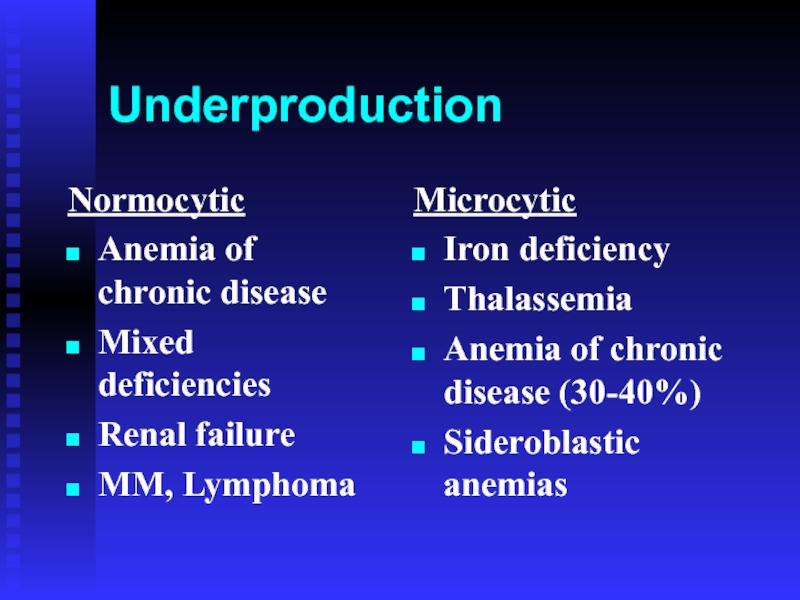
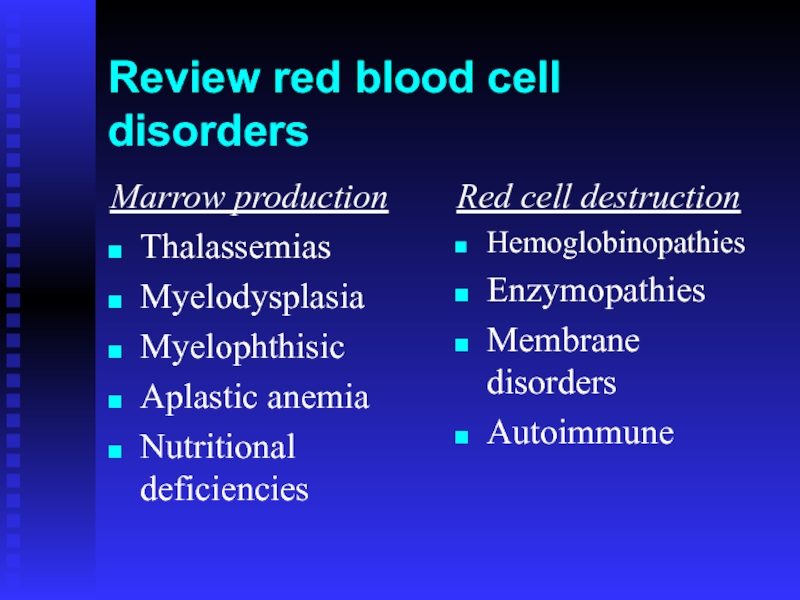
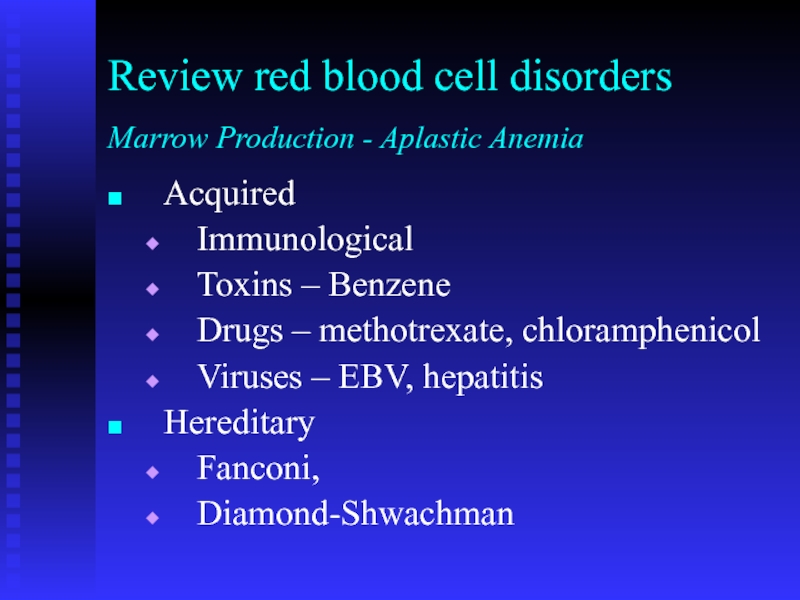
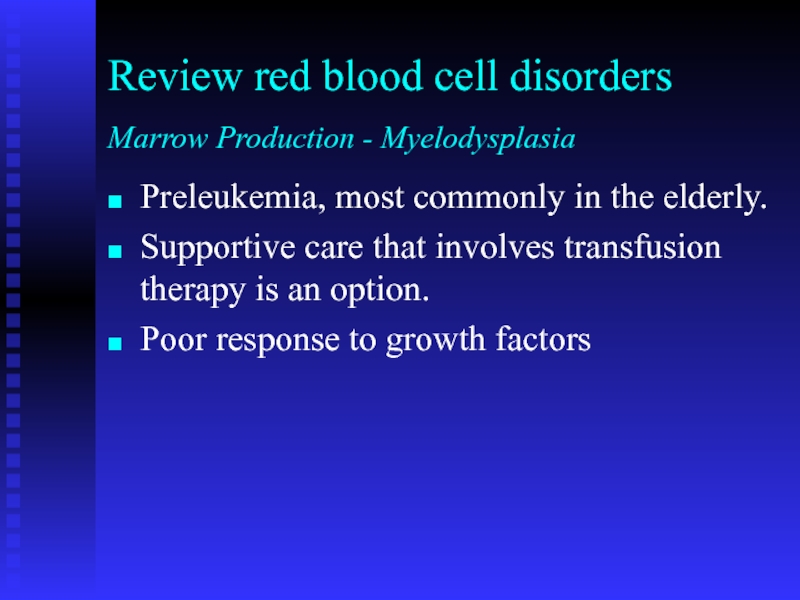
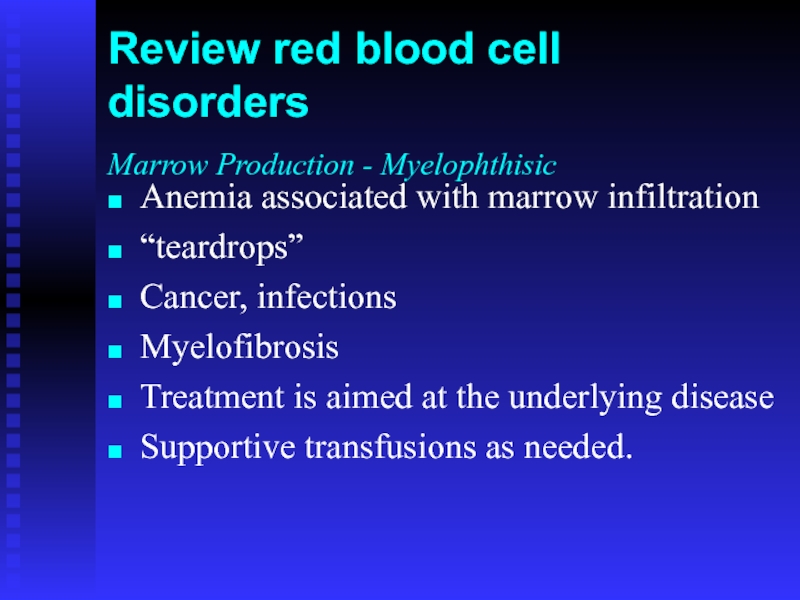
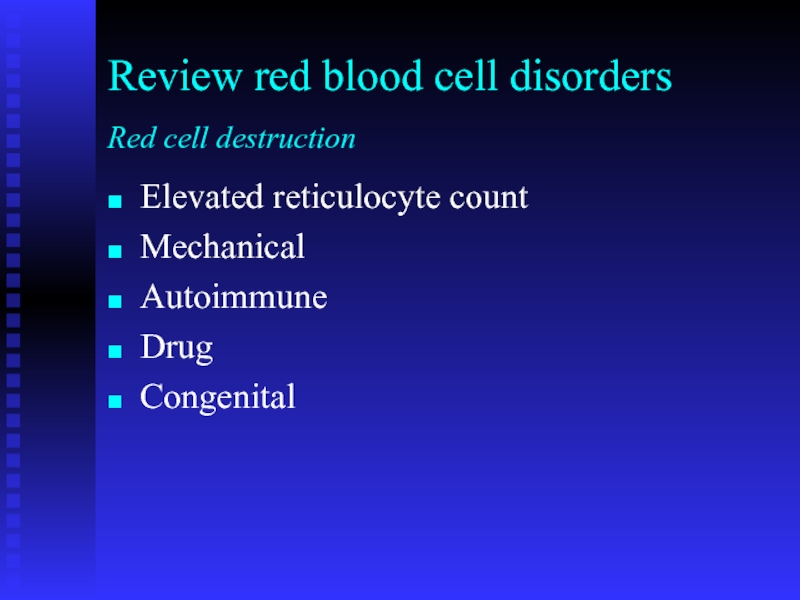
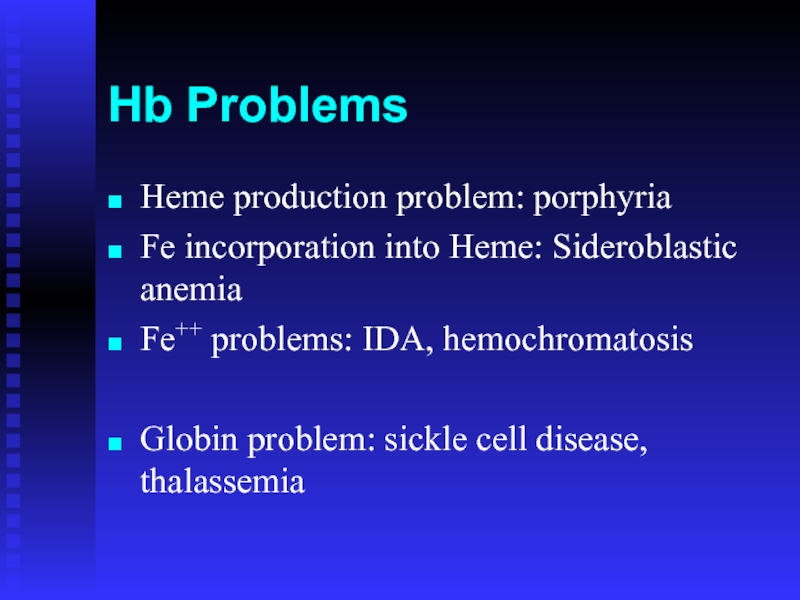
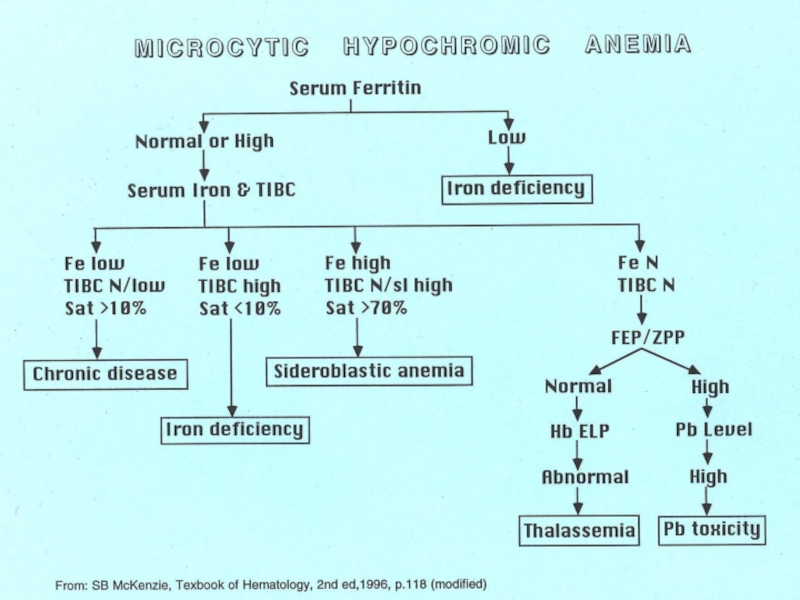
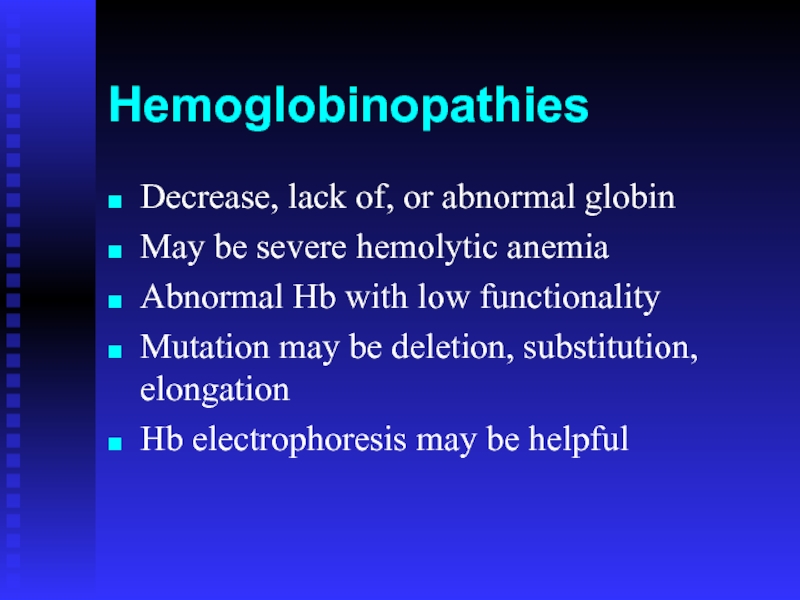
![HemoglobinHemePorphyrin ring and FeGlobinsAlpha family on chromosome 16−−[ζ]--//--[α2]−−[α1]−−Beta family on chromosome 11−−[ε]--//--[γ]--[γ]−−[δ]−−[β]−−](/img/tmb/5/481070/6359c5baf3bc52f553ca698e2c8e1a47-800x.jpg)
